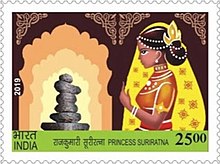Gimhae Gim clan
The Gimhae Gim clan (Korean: 김해 김씨; Hanja: 金海 金氏) is one of the Korean clans. This clan traces their origin to King Suro and his Queen Heo Hwang-ok, who are mentioned in the 13th-century Korean chronicle Samguk Yusa.[1][2] King Suro was the founder of Gaya confederacy, and his descendant Gim Yu-sin is renowned for unifying the Silla polity.[1][3]
| Gimhae Gim clan | |
|---|---|
 | |
| Country | Korea |
| Current region | Gimhae |
| Founder | Suro |
| Connected members | Kim Boo-kyum Kim Moo-sung Kim Dae-jung Kim Jong-pil Kim Hyong-uk Kim Won-bong Andrew Kim Taegon Gim Hongdo Kim Ung-seo Gim Yu-sin Gim Mu-ryeok Kim Min-Seok Kim Ki-bum (Key) Kim Jong-woon/Kim Jong-hoon (Yesung) |
More than six million present day Koreans, especially from Gimhae Kim, Heo and Lee (Yi) clans, trace their lineage to the legendary queen as the direct descendants of Queen Heo Hwang-ok's children with King Kim Suro.[4][5][6] These 3 clans associate their Bon-gwan (geo-biological lineage roots) to Gimhae in South Gyeongsang Province of Korea,[3] and these clans place restrictions on marriage with each other due to the shared ancestors. Today, the Gimhae Gim clan is the largest clan group among them.[3] Gimhae Gim clan and Gimhae Heo clan, descended from the two sons of King Suro who used their mother's Queen Heo Hwang-ok's surname, instead of their father's.
According to Samguk Yusa Queen Heo Hwang-ok became the wife of King Suro of Geumgwan Gaya at the age of 16, after having arrived in Gaya confederacy in Korea in the year 48 AD by boat from a distant kingdom called "Ayuta",[1][7][5][8][6] making her the first queen of Geumgwan Gaya. Her native kingdom is believed to be located in India by some; there is, however, no mention of her in any pre-modern Indian sources.[6] There are tomb in Gimhae in Korea, that are believed by some to be of King Suro and Queen Heo,[9] and a memorial of Queen Heo Hwang-ok in Hindu holy city of Ayodhya in India.[1][10][11]
Origin
The Gimhae Heo clan founder was King Suro, whose wife was Queen Heo Hwang-ok. She set sail from India, later arriving at Gimhae.[12] Some sources have identified Ayodhya in North India as the native place of Queen Heo Hwang-ok,[4] while other sources identify her being of tamil origin from South India.[12]
In 2004, scientific proof demonstrated that Heo Hwang-ok was a person of Indian origin. 徐廷송, professor at the Faculty of Medicine at Seoul University, and 김정일, professor at Faculty of Medicine at Hallym University, reported their finding to The Genetics Society of Korea.[12] Having analyzed remains in an old burial mound containing what they assumed are remains of the Heo Hwang-ok clan, they concluded that Heo Hwang-ok's ancestor was not from Northern Mongolia (origination of Koreans) but from Southern Indian. Her clan dates back to Pandya’s clan in India. These findings were based on analyses of sampled Mitochondrial DNA.[12] Heo Hwang-ok may be a queen of the Satavahana dynasty in India. She came to the Gaya confederacy in the year 48 AD. Some suggest that Heo came from Tamil Nadu, as many Koreans words that sound similar to the words used in the region. Academics are split as to her true origin. The connection between the two cultures is believed to date back to the reign of King Suro and Ayi of Pandya Kingdom in 45 AD. Experts don't rule out the possibility of Queen Huh (Queen Heo Hwang-ok) bringing Tamil culture to Korea with her when she left India, according to Korean envoy Kygsoo Kim.[2] Queen Heo Hwang-ok bore ten children. Two of them were given Heo's surname, and they were the origin of Gimhae Heo clan. According to the Samguk Sagi, Gim Yu-sin was 12 th grandchildren of Suro.
Queen Heo Hwang-ok's association with Ayodhya is based on the book "Heo Hwang-ok Route: From India to Gaya of Korea" by a Senior Archeologist and Emeritus Professor at Hanyang University, Kim Byung-mo,[4] which is considered speculative by some.[6][1] Memorial of Heo Hwang-ok in Ayodhya,[13] is visited by a large number of Koreans, especially around jesa in April, to pay tribute to Queen Heo Hwang-ok as she is considered an ancestor to large number of Koreans. She was supposedly of Indian-origin from Ayodhya and had traveled to Korea to marry King Suro of Geumgwan Gaya in 48 CE.[13][14][15][16]
Gallery
 A commemorative Rs. 25.00 postage stamp on Princess Suriratna (Queen Heo Hwang-ok ) was issued by India in 2019.
A commemorative Rs. 25.00 postage stamp on Princess Suriratna (Queen Heo Hwang-ok ) was issued by India in 2019. A commemorative Rs. 5.00 postage stamp on Queen Heo Hwang-ok (Princess Suriratna) was issued by India in 2019.
A commemorative Rs. 5.00 postage stamp on Queen Heo Hwang-ok (Princess Suriratna) was issued by India in 2019. Tomb of King Suro in Gimhae.
Tomb of King Suro in Gimhae. Tomb of Heo Hwang-ok (Queen of King Suro) in Gimhae.
Tomb of Heo Hwang-ok (Queen of King Suro) in Gimhae.
See also
References
- "Korean memorial to Indian princess". BBC News. 6 March 2001.
- , Times of India, Jul 19, 2016.
- Academy of Korean Studies 김해김씨 金海金氏. Academy of Korean Studies.
- Legacy of Queen Suriratn, The Korea Times, 16 April 2017.
- Kim Choong Soon, 2011, Voices of Foreign Brides: The Roots and Development of Multiculturalism in Korea, AltairaPress, USA, Page 30-35.
- "Korean memorial to Indian princess". BBC News. 3 May 2001.
- No. 2039《三國遺事》CBETA 電子佛典 V1.21 普及版 Archived 2016-03-03 at the Wayback Machine, Taisho Tripitaka Vol. 49, CBETA Chinese Electronic Tripitaka V1.21, Normalized Version, T49n2039_p0983b14(07)
- Il-yeon (tr. by Ha Tae-Hung & Grafton K. Mintz) (1972). Samguk Yusa. Seoul: Yonsei University Press. ISBN 89-7141-017-5.
- Kwon Ju-hyeon (권주현) (2003). 가야인의 삶과 문화 (Gayain-ui salm-gwa munhwa, The culture and life of the Gaya people). Seoul: Hyean. pp. 212–214. ISBN 89-8494-221-9.
- "UP's Faizabad district to be known as Ayodhya, says Yogi Adityanath". 6 November 2018. Retrieved 7 November 2018.
- "Site for Heo Hwang-ok memorial in Ayodhya finalised". 2 November 2018. Retrieved 7 November 2018.
- "金首露王の夫人の「インド渡来説」科学的な証拠". JoongAng Ilbo. 2004-08-19. Archived from the original on 2016-09-11.
- Work on Queen Heo Memorial in Ayodhya likely to be completed in 2 years, The Week (Indian magazine), 18 December 2018.
- Il-yeon (tr. by Ha Tae-Hung & Grafton K. Mintz) (1972). Samguk Yusa. Seoul: Yonsei University Press. ISBN 89-7141-017-5.
- The Indian princess who became a South Korean queen, 4 November 2018, BBC
- Why 60 lakh Koreans consider Lord Ram's Ayodhya their maternal home?, 4 March 2016, Zee News